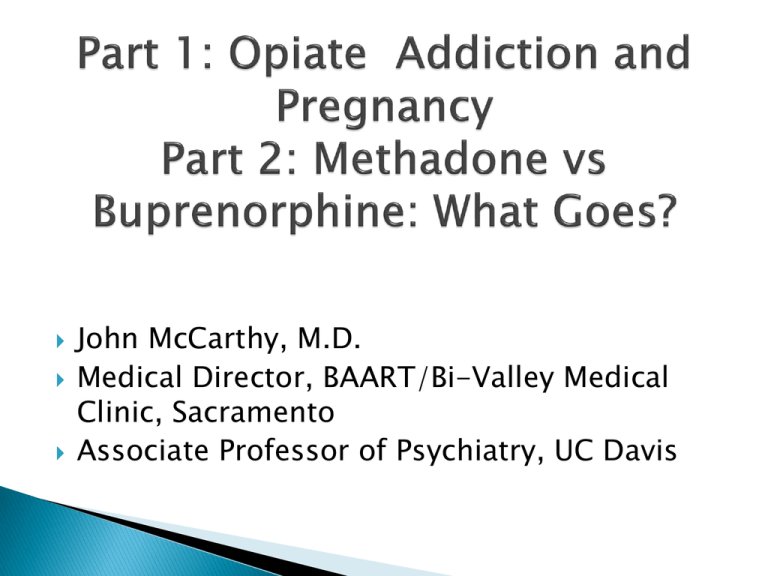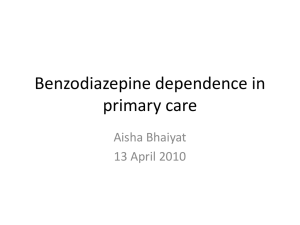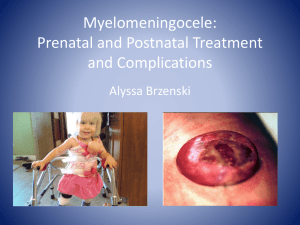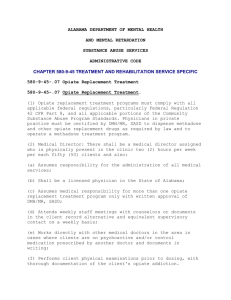Opiate Addiction and Pregnancy Part 2: Methadone vs Buprenorphine
advertisement

John McCarthy, M.D. Medical Director, BAART/Bi-Valley Medical Clinic, Sacramento Associate Professor of Psychiatry, UC Davis Open Letter to the Media and Policy Makers Regarding Alarmist and Inaccurate Reporting on Prescription Opiate Use by Pregnant Women March 11, 2013 National Advocates for Pregnant Women, 15 West 36th Street, Suite 901, New York, NY 10018 Between 2000-2009 antepartum opiate use increased five fold in pregnant women (Patrick et al JAMA 2012) Neonatal abstinence increased nearly three fold. (Patrick et al) Most of this increase reflects prescription opiate abuse/addiction. The average age on admission to Bi-Valley programs went from 42 to under 30 years in the space of about 5 years. About 40% of young admissions are women • • • Fetal and neonatal mortality from untreated heroin addiction was 10% (Fricker and Segal, 1978) Fetal and neonatal demise from maternal heroin addiction was 4 times general population: 12 stillbirths and 25 neonatal deaths among 792 cases. Autopsy: focal CNS hemorrhages from fetal hypoxia during opiate withdrawal (Rementeria and Nunag 1973) During severe withdrawal, oxygen supply goes down, oxygen demand goes up Is it to protect the fetus from methadone? Meaning use low doses and/or reduced doses and have the mother tough it out or even relapse to drug use. Or is it to protect the fetus from withdrawal? Meaning treat maternal withdrawal with dose increases to protect the fetus from intrauterine abstinence and have a mother who is not chronically sick. • • • A recent meta-analysis of the relationship of methadone dose to neonatal abstinence syndrome (NAS) reviewed 67 studies (Cleary: 2010). The last research study of human fetal opiate abstinence was in 1975 (Zuspan) The first summary of intrauterine abstinence syndrome (IAS): 2011 McCarthy (J Maternal Fetal Neonatal Medicine) Zuspan et al, reporting on the effects of a 1973 FDA mandate that forced a 21-day withdrawal on all pregnant women, documented one fetal death during withdrawal which they attributed to this process “since violent intrauterine movements preceded the still birth” They reported knowledge of four similar deaths. They then used serial amniotic fluid amine assays to monitor the fetus during withdrawal. After methadone decreases of 5 and 3 mg, epinephrine and norepinephrine values were 8–10 times higher than baseline. Because of the evidence of fetal stress, the dose was increased and fetal catecholamine levels improved. Maternal catecholamine levels were normal, indicating a purely fetal stress response. The authors recommended against detoxification during pregnancy, unless a scientific means is available to monitor fetal homeostasis. Cleary et al in a meta-analysis of 67 studies of methadone dose and NAS found 4 different approaches to dosing 1. withdrawal 2. maintenance on low doses 3. maintenance as needed and then reduced doses 4. dose increases as needed to treat maternal withdrawal Methadone is metabolized by hepatic enzymes (3A4, 2D6) for which there is significant genetic diversity causing diversity in metabolic rates. The ½ life can vary between 18-36 hrs. Pregnancy accelerates methadone metabolism. It converts women into rapid metabolizers. CYP3A is consistently and significantly increased in all stages of pregnancy. It may occur before the woman is aware she is pregnant. Genetic testing is now available. The fetus is exposed only to the serum, not the oral dose. If methadone is cleared rapidly then the dose can be quite high (415mg, 70mg q4h) and yet fetal exposure quite low, (e.g 90mg TID with trough methadone below detection) May expose the fetus to daily episodes of ‘oversedation’ and withdrawal An ultrasound study of single and split doses by Whittmann and Segal found significant fetal behavioral abnormalities on single dose regimens, including percent of time spent breathing, number of rotational body movements, and longest period of fetal activity prior to the AM dose. These changes normalized on a BID regimen. Cardiac parameters have also been shown to normalize on BID regimen Reduces or eliminates fetal methadone peaks and troughs which are not physiologic for the fetus May allow maintenance on lower doses By reducing maternal withdrawal stress, it makes for a healthier pregnancy Reduces maternal anxiety about withdrawal Reduces risks of relapse Average and mean dose 152mg/day, divided between 3-6 times a day. Drug of choice on admission 71% prescription opiates (hydocodone or oxycodone), 29% heroin Average serum level 288ng/ml (therapeutic range for trough levels is 200-600ng/ml) Mean gestational age 38.2 weeks (r 23-42) Full term (N=51/62) 82% Mean weight 2903 grms (6lb 8oz) (r 5643883) Full term weight (N=51) 3119gm 92% of infant toxicology screens were negative for illicit drugs 80% of neonates were nursed 29% were treated for NAS (N=18/62) The literature reports 50-80% of babies exposed to methadone need treatment LOS in hospital 10 days. Rx’d 22 days; not Rx’d 3.8 days 25 female babies only 4 treated (16%) 37 male babies, 14 treated (38%) Seiko in England reports a rate of treatment of 11%: the lowest rate of treatment ever reported. Abrahams in Vancouver reports a treatment rate of 30% Do neonates go into withdrawal from the mother? (Maternal Absence Syndrome) Do NICU environments exacerbate NAS? How necessary are NICUs for NAS management? Can NAS scoring be done with the mother present? Dutch War Baby syndrome Fetal Origins Hypothesis (Barker) Maternal stress increases fetal exposure to stress hormones, adrenalin, corticosteroids, which have been shown to have long term adverse developmental consequences for the child. Both mu opiate receptor agonists Both cause continue physical dependence and withdrawal risks Both long acting with theoretical once a day dosing. But multi-dosing regimens are necessary in many patients Both effective treatments for opiate addiction Both may have beneficial psychotropic effects, e.g. anti-anxiety, anti-depressant, anti-psychotic effects that are not well understood or clarified Methadone is full opiate agonist; bup is a partial agonist with a ceiling effect on respiratory depression making bup safer in misuse or overdose situations Bup is an opiate antagonist (narcan like) when other opiates are present. It can cause severe precipitated withdrawal. Methadone has no such risks and is therefore safer for induction. Methadone is more effective in retaining patients in treatment, at least for more severe addictions Methadone has more side effects, e.g weight gain, sweating, sedation Although there are some studies that suggest bup has a milder withdrawal, there is no evidence that there is any greater success with continued recovery off the medication At low doses (like what a fetus is exposed to) both methadone and buprenorphine are full opiate agonists! Withdrawal symptoms may be similar. Brain recovery involves endorphin and opiate receptor synthesis and a physical recovery process that may be unrelated to either methadone or buprenorphine Bup seems to be more abusable, especially by IV route. Addition of naloxone (Suboxone) of questionable efficacy in preventing abuse (Australian study), but that is at least the political justification. Buprenorphine is an easier treatment modality for the patient to access because regulations are minimal compared to methadone. But treatment intensity and perhaps effectiveness is better with methadone because of the added structure and counseling.











